
By: Adam Muggleton, Marina Kindelan, Martin Williamson
Date Published: September 4, 2024
In the intricate world of building design, where systems intersect and influence each other, the building envelope stands out as perhaps the most critical system of all. Often referred to as the “skin” of a building, the envelope does far more than simply define the structure’s architectural style and aesthetics; it serves as the crucial barrier between the conditioned interior and the unconditioned exterior, playing a pivotal role in a building’s overall performance.
The building envelope’s significance extends beyond mere aesthetics. It is a key factor for several critical functions, including:
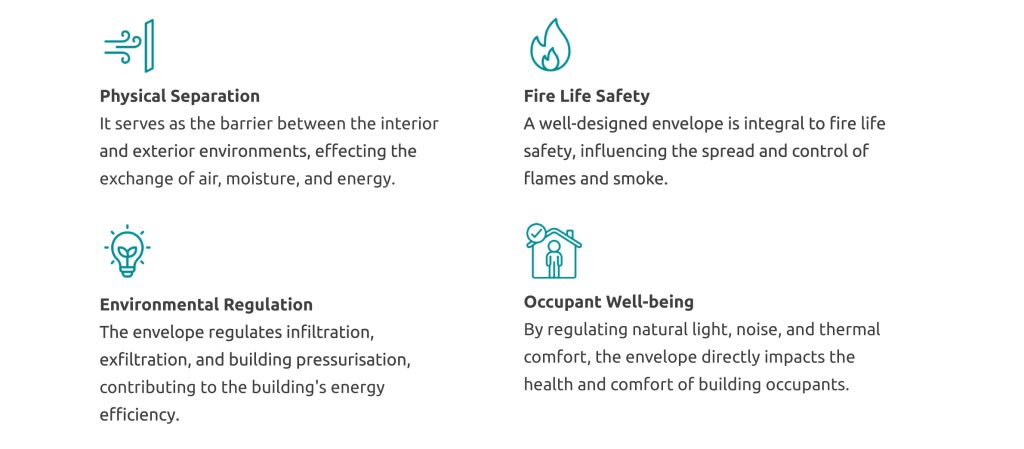
Given these roles, the building envelope is undeniably a system that warrants meticulous attention during design, construction, and commissioning. In a world increasingly focused on achieving Net Zero energy, water, and carbon targets, the envelope must be a “first principle” in sustainable building design.
The building envelope is a complex system with multiple roles and far-reaching influences on a building’s performance. As the interface between the interior and exterior environments, it must balance a variety of functions, from providing protection against the elements to enhancing indoor environmental quality (IEQ).
The diagram below illustrates the intricate network of interactions, protections, regulations, and technologies that the building envelope incorporates.
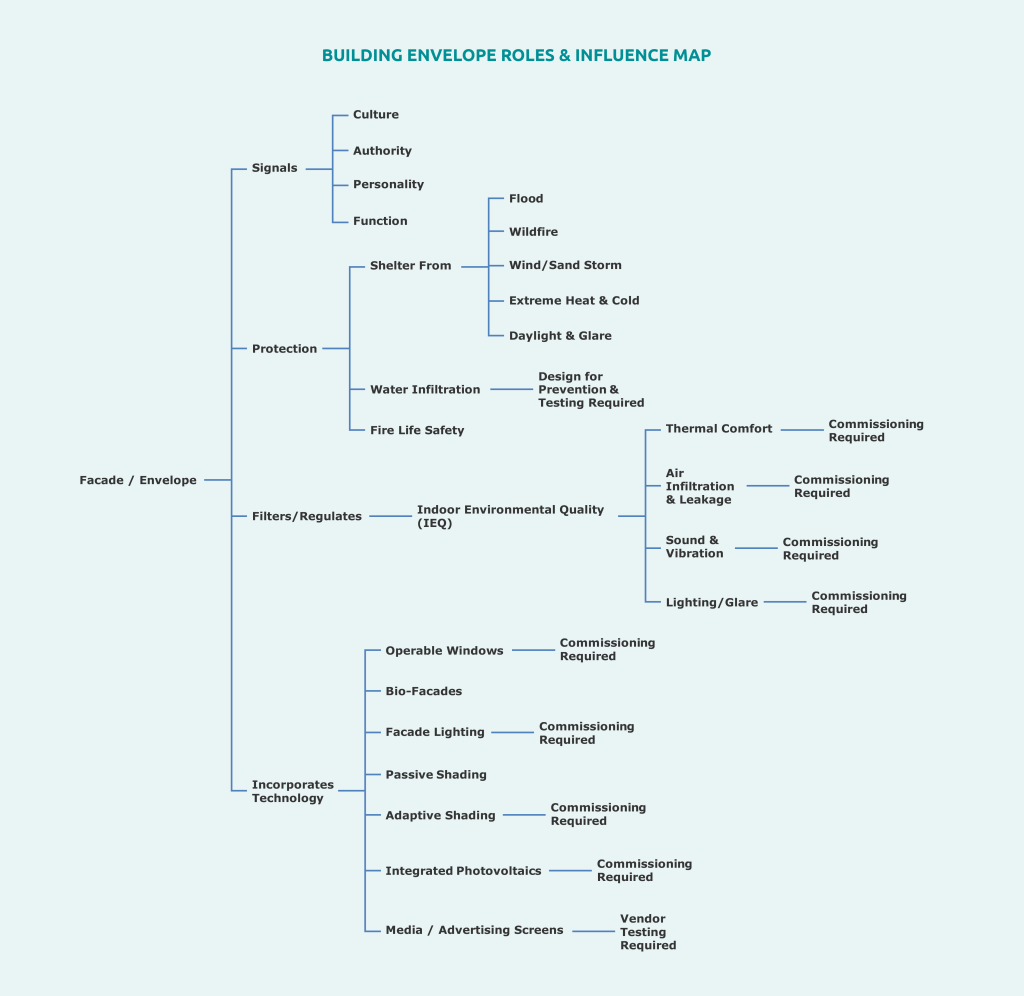
This map highlights the necessity of an Integrated Design Process (IDP) to achieve a high-performance building envelope. The envelope is responsible for everything from signalling a building’s cultural and architectural identity to ensuring protection against environmental threats like floods, fire, and extreme temperatures. It also plays a critical role in filtering and regulating factors such as air infiltration, thermal comfort, and sound insulation, all of which require precise design and commissioning.
Moreover, the building envelope increasingly incorporates advanced technologies, from operable windows and bio-façades to integrated photovoltaics and adaptive shading systems. These technologies not only enhance the envelope’s functionality but also demand rigorous commissioning to ensure they perform as intended. The growing complexity of these systems underlines the need for a holistic approach to design, where all elements are considered together to optimise the overall performance of the building.
Through careful planning and an IDP, each of these factors can be managed effectively, resulting in a building envelope that not only meets but exceeds performance expectations.
Operationally, the building envelope, including the façade and roof, is a key driver of energy consumption. Energy use related to heating, cooling, and lighting can account for up to 65% of a building’s total energy consumption. The impact of the envelope on a building’s operational energy consumption is profound, but the financial implications are equally significant.
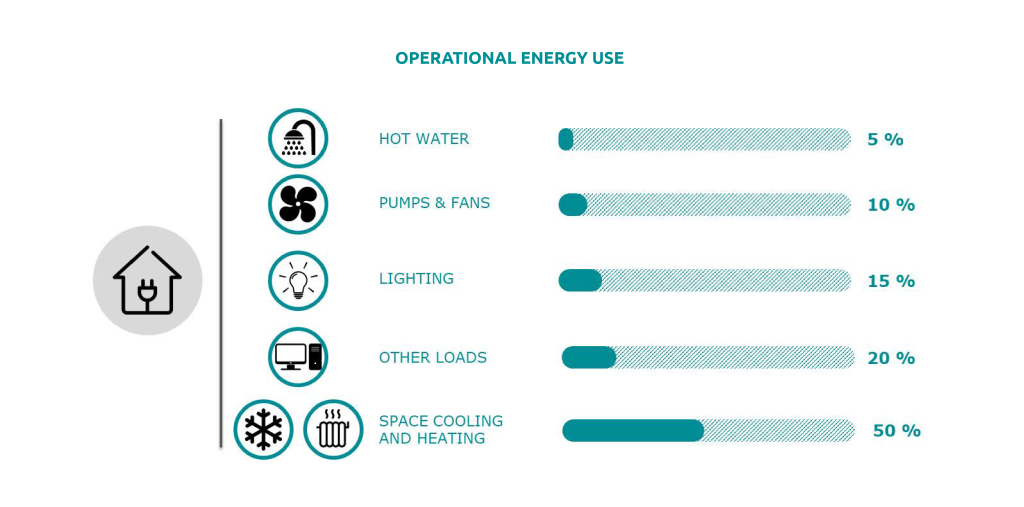
Research from AESG highlights that the building envelope can account for 20% to 35% of total construction costs, depending on materials, design complexity, energy efficiency requirements, and geographical location. Additionally, the envelope represents approximately 75%1 of construction-related disputes in North America, underscoring the importance of managing this risk from design through to commissioning and handover.

Building on the operational impact, it’s important to consider the significant financial implications associated with constructing the building envelope. The costs of designing and constructing the building envelope are driven by several factors, including its complexity, the need for high-quality and specialised materials and the skilled labour required. The integration of advanced technologies, along with stringent performance requirements and compliance with environmental and safety regulations, further adds to overall costs.
These financial implications present considerable risks that must be managed carefully from the design phase through to commissioning and handover. Early involvement of a façade/envelope consultant is essential in mitigating these risks. By ensuring that the building envelope meets all regulatory requirements and best practices, these consultants help to accurately estimate the costs and risks involved, thereby reducing the potential for costly disputes and legal actions later on.
From a cost management perspective, both capital expenditure (CapEx) and operational expenditure (OpEx) need to be thoroughly analysed and budgeted. However, current practices often focus primarily on CapEx, neglecting the critical importance of OpEx. The “CapEx & OpEx Equation” diagram highlights the relationship between these costs, showing how initial investments (CapEx) translate into ongoing operational costs (OpEx) over the building’s lifespan.

In a world increasingly targeting Net Zero water use, traditional practices such as cleaning façades with potable water are becoming unsustainable. Moreover, if substandard materials are selected, the OpEx related to maintenance can quickly become untenable, sometimes requiring façade and roof replacements within just a few years. Therefore, in my opinion, it’s crucial to design the building envelope with long-term durability in mind to manage these costs effectively.
With global carbon reduction targets now enshrined in regulations across the USA, EU, UK, Canada, and Australia, designing the building envelope with both embodied and operational carbon in mind is not just a sustainability measure—it’s a risk management strategy. Embodied carbon emissions are locked in once construction is complete, making it critical to address these concerns during the design phase.
AESG research estimates that the building envelope accounts for approximately 16%2,3 of a building’s embodied CO2 emissions and 34%2,3 of its operational CO2 emissions. Therefore, in my opinion, optimising the building’s net carbon emissions is a key responsibility of the design team.


The image above illustrates the key components that contribute to a building’s net carbon emissions, with a focus on the building envelope. The equation balances embodied carbon (emissions from materials and construction), operational carbon (emissions during the building’s use), and avoided emissions (reductions achieved through strategies like renewable energy). Together, these elements highlight the importance of considering the full lifecycle impact of a building when striving for sustainability and Net Zero targets. This equation serves as a strategic framework for optimising both design and operational decisions to reduce overall carbon emissions.
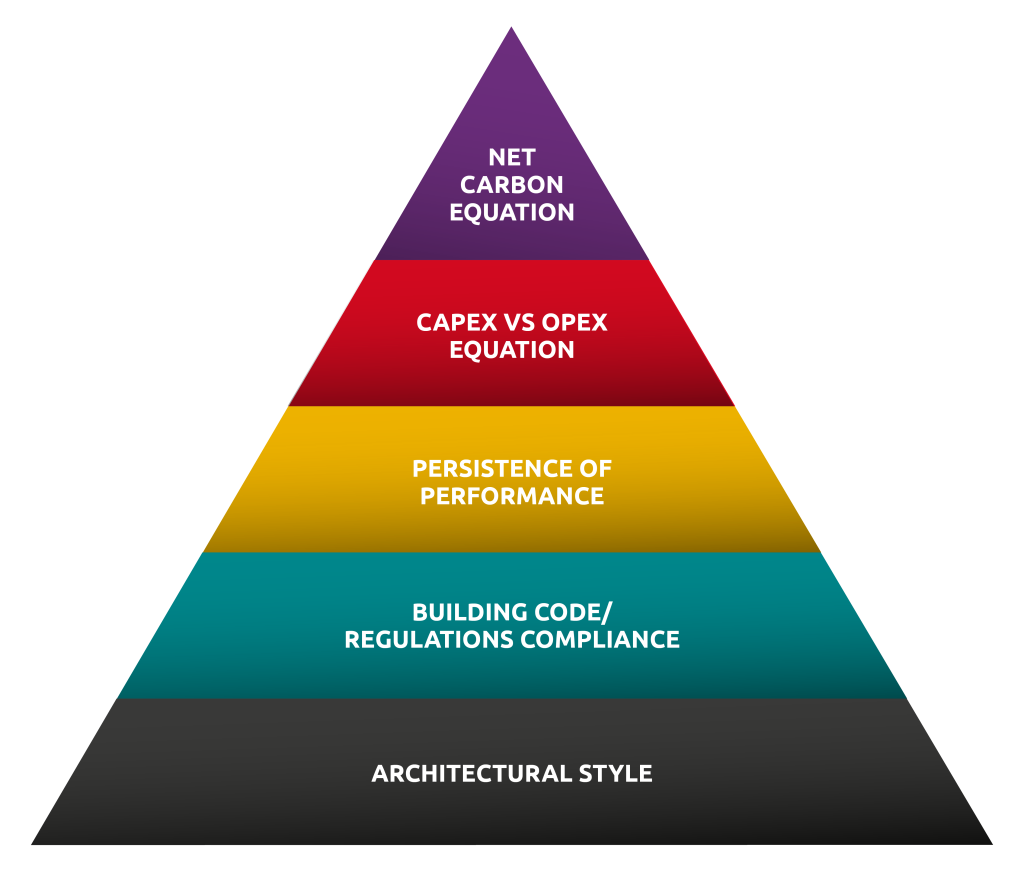
As we now recognise the critical role of the building envelope, it’s essential to approach its design with a structured hierarchy of principles, similar to Maslow’s Hierarchy of Needs. At the foundation, architectural integrity and regulatory compliance ensure the envelope meets both aesthetic and legal standards. Moving up, performance longevity and cost efficiency (balancing CapEx and OpEx) are vital for sustaining value over time. At the peak, carbon optimisation is the ultimate goal, ensuring that every decision contributes to a sustainable future. This hierarchy is not just a checklist—it’s a strategy for designing envelopes that are resilient, efficient, and forward-thinking.
Commissioning of the building envelope is not just a best practice—it’s a necessity that must begin during the early design stages. This requirement is mandated by several key regulations, codes, and certification programs, including:
• USGBC LEED Program
• ASHRAE Guideline 0
• CIBSE Commissioning Code M 2022
• BREEAM Program
• UK Building Regulations
The significance of Building Envelope Commissioning (BECx) lies in the profound effects the building envelope has on carbon emissions, energy use, and occupant well-being. From my perspective, the building envelope is a mission-critical system that directly influences a building’s overall performance and sustainability outcomes.
However, despite its importance, BECx is not yet standard practice. In my opinion, this can be attributed to three main factors:

Given the publicly stated 2050 carbon neutrality and net zero energy targets by major economies, the stakes for effective building envelope commissioning are higher than ever. In my view, property owners will increasingly need to prove that their buildings meet specified performance standards and can verify this post-occupancy. Ignoring BECx will increasingly resemble value engineering taken too far, with potentially severe consequences.
BECx is a specialists, quality-focused process that verifies and documents every aspect of the building envelope system from planning and design to installation, inspection, testing, and maintenance. It provides critical evidentiary records, verifying that the envelope performs as intended. BECx should be conducted by qualified, independent technical specialists with domain expertise, as it is not a mere tick-box exercise but a crucial technical discipline.
BECx involves a three-phase process, with each phase encompassing multiple discrete tasks, ensuring that the building envelope meets all performance criteria throughout its lifecycle.

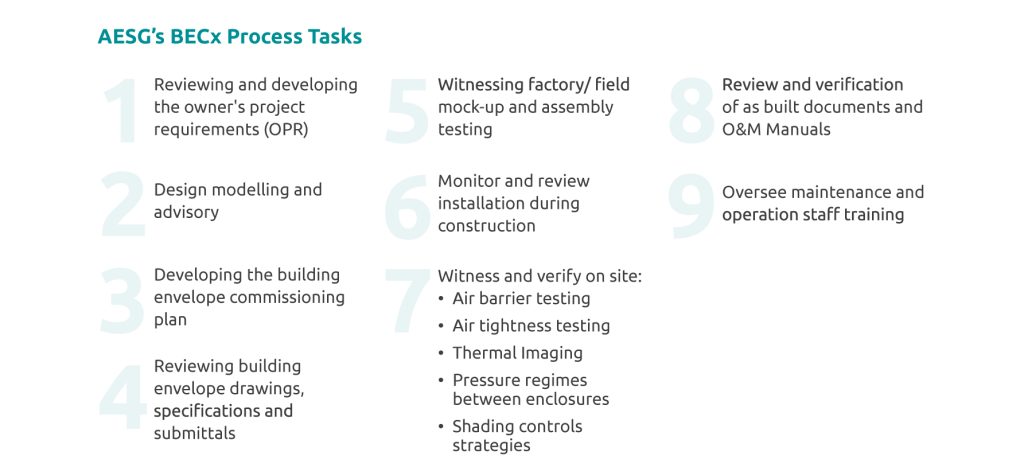
Façades can be “intelligent,” “smart,” and “performative,” incorporating advanced technologies like monitoring systems, automatic shading, integrated displays and lighting technologies. These features transform façades into a critical component of the building’s toolkit for demand response and energy reduction.
However, this added technological complexity requires careful consideration. Functional Performance Testing (FPT) and Integrated Systems Testing (IST) during commissioning are essential to ensure these active façades perform as intended.
Unlike “plug & play” systems, active façades need thorough testing and tuning to work seamlessly with other building systems, making them an integral part of the “smart building” toolkit.
So, is the building envelope the most important building system? In my opinion, it is. The building envelope is the key variable in unlocking energy savings, ensuring occupant comfort, and achieving Net Zero energy and carbon targets.
The building envelope is crucial for unlocking energy savings, enhancing occupant comfort, and achieving Net Zero energy and carbon goals. At AESG, we bring a unique, multidisciplinary approach to these challenges:
![]() Expertise in Façades
Expertise in Façades
Our in-house team of façade engineering and modelling experts, led by industry thought leaders, ensures that every project meets the highest standards of design and performance.
![]() Leading Commissioning Team
Leading Commissioning Team
With one of the largest and most experienced building commissioning teams in the Middle East, AESG is certified by ACG USA.
![]() Exclusive Certification
Exclusive Certification
We are the only firm in the Middle East certified for comprehensive building envelope commissioning.
For a complimentary discovery meeting on building envelope design, analysis, surveys, or expert witness support, connect with Marina Kindelan.
For insights into building envelope commissioning, commissioning management, and digital handover, connect with Martin Williamson.
1. BCTA. (2024). Risk Management Course.
2. Architecture 2030. (2017). UN Environment Global Status Report.
3. U.S. Energy Information Administration. (2017). International Energy Outlook 2017.
AESG is an international consultancy, engineering and advisory firm with regional headquarters in London, Dubai, Riyadh, Singapore and South Africa. We are actively engaged in projects spanning across Europe, Asia, and the Middle East. We have one of the largest dedicated teams with decades of cumulative experience in sustainable design, sustainable engineering, fire and life safety, façade engineering, commissioning, digital delivery, waste management, environmental consultancy, security consultancy, strategy and advisory, acoustics, cost management and carbon management.

Chief Technical Officer, AESG
Adam is AESG’s Chief of Technical Officer. He has worked on projects in 21 countries, held leadership positions at several firms and is an advocate for high performance buildings. Adam has a unique skill set derived from experience in property development, design team and project management plus building commissioning. Adam is passionate about promoting the concept of commissioning management as an effective project management tool, to hand over high performance buildings. Adam devises and delivers successful project, leadership and testing strategies that achieve optimum outcomes for all involved and affected.
As well as being an industry philosopher, blogger and podcaster, Adam has contributed to several commissioning codes & guides. He also has unique knowledge and experience leading digital solutions for building commissioning and building information asset management.

Director of Façades – ME, AESG
Marina is AESG’s Façades Director. Since joining the firm in 2017, she has been involved in a varied range of projects such as the writing of thermal insulation guidelines and has worked on some impressive projects across multiple sectors, including master planning, critical infrastructure, hospitality, residential, commercial, retail and high rise.
She has over 10 years of professional experience in various countries such as Korea, UK, and the UAE. She is involved from the early stages streamlining the façade design process through solid management skills and design flair to tender documentation. She possesses a solid background on façade systems, detailing and materials across these different countries. She was one of the finalists for the ‘Women in Construction: Professional of the Year’ at the ME Consultant Awards 2020 and has actively participated in numerous conferences and events where she has actively advocated for efficient and sustainable developments.

Director of Commissioning, AESG
As the Director of Commissioning at AESG, Martin oversees all aspects of the commissioning process for various prestigious projects in the Middle East region, from design review to performance testing of building services systems.
With over 15 years of professional experience in the construction industry, Martin has successfully delivered multiple projects in the UK, Australia, New Zealand, and the UAE, ranging from hospitals to mixed- use commercial buildings, malls and hotels.
Martin leads a diverse group of multi-discipline commissioning professionals from an operational and technical standpoint. Martin is passionate about enhancing the energy efficiency, indoor environmental quality, and operational performance of buildings through a quality-focused commissioning process.
For further information relating to specialist consultancy engineering services, feel free to contact us